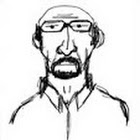Christopher Pike: That's a technicality.
Spock: I am Vulcan, sir. We embrace technicalities.
Christopher Pike: Are you giving me attitude, Spock?
Spock: I am expressing multiple attitudes simultaneously sir, to which one are you referring?
Star Trek: Into Darkness
I freely admit that when I headed over to the
Scotiabank Theatre last night to see
Star Trek: Into Darkness, it was pretty much out of a sense of duty. I was disappointed by the first movie of the Abrams reboot: too many holes in the plot, the alternate future concept didn't work for me at all, people kept beating Kirk up, and the
engine room looked like a brewery. Frankly, I expected more of the same with
Into Darkness, but I've had an unused twenty-five dollar
Famous Players gift card floating around since Christmas, and this was probably my only chance to see this movie on the big screen.
To my mild surprise, I found that in some ways I very much enjoyed
Into Darkness.
It still suffers from the same sort of issues and inconsistencies as the
first film, and the art direction still isn't working for
me (in other words, the engine room still looks like the factory floor
at Molson's) but they're starting to establish the elements of character which were the greatest strength of the original series.
One of the brilliant things that Gene Roddenberry did in
Star Trek was to create the triangle of Will, Logic and Emotion represented by Kirk, Spock and McCoy. By splitting these personality traits between three characters, he gave the writers of the episodes an unprecedented tool for externalizing and verbalizing the debates and conflicts between these aspects of the human soul.
The fascinating thing about
Into Darkness is that we begin to see the development of that three-sided synergy, but it's not between Kirk, Spock and McCoy - in the new version, Uhura is well on the way to replacing the good doctor in that part of the triad. In the original series, it might not have worked, but the introduction of the romantic relationship between Spock and Uhura allows her access to the dynamic between the two men, and that relationship also lets the writers introduce a completely different level of interaction between the characters. Spock's feelings for Uhura could humanize him in a way that would have been impossible in the original series, and force him to accept parts of his personality that otherwise would never be allow to surface.

They'll have to be careful, though, or else the Spock/Uhura relationship will be separate from the Spock/Kirk relationship, hereby losing the strength of the original combination. Can Uhura become Kirk's confidant and friend in the same way that McCoy did? It seems far more likely that she'll need to create a different framework for interacting with the captain.
So far there's no suggestion that the triangle will become a square, that McCoy will emerge as an equal in the interaction of the main characters. There's a bit of an attempt to place McCoy in his original role, but it's not maintained throughout the course of the story - it's almost like they're doing it because that's the sort of dialogue that was written for the character in the original series.
In fact, that sort of homage to the original made the whole thing a bit strange as far as I was concerned. Watching
Into Darkness was like watching a really well done fan tribute to the Sixties version, one with a huge budget, loaded with all the right
references, and with professional actors doing brilliant impersonations
of the people who originally performed the roles. There were several
times last night when I found myself thinking, “Wow, this Quinto guy
just did a great impression of Leonard Nimoy, that was bang on!" and the
manner in which Karl Urban is channeling the ghost of DeForest Kelley
is more than a little eerie.
Similarly, they chose to rework one of the original
episodes, albeit in the rebooted universe. What if they continue to mine those episodes for future movie concepts? It would be an awful temptation to rework
classic scripts like
The City at the Edge of Forever*,
Amok Time,
Balance of Terror, and so on, but I think that would be an unfortunate error. To make the reboot succeed, they're going to have to take a fresh look at the universe created by Gene Roddenberry, and also allow the actors some freedom to make the roles their own, rather than just imitations of the original portrayals.
Which is as it should be. Reboot or not, shouldn't they be boldly going where no one has gone before?
- Sid
* And get their asses sued by Harlan Ellison.
July 23rd, 2013: comments closed due to just ridiculous spamming. I'd love to blame Eastern Europe exclusively, but there's some air conditioning company in the States that seems to be a frequent flyer as well.
































